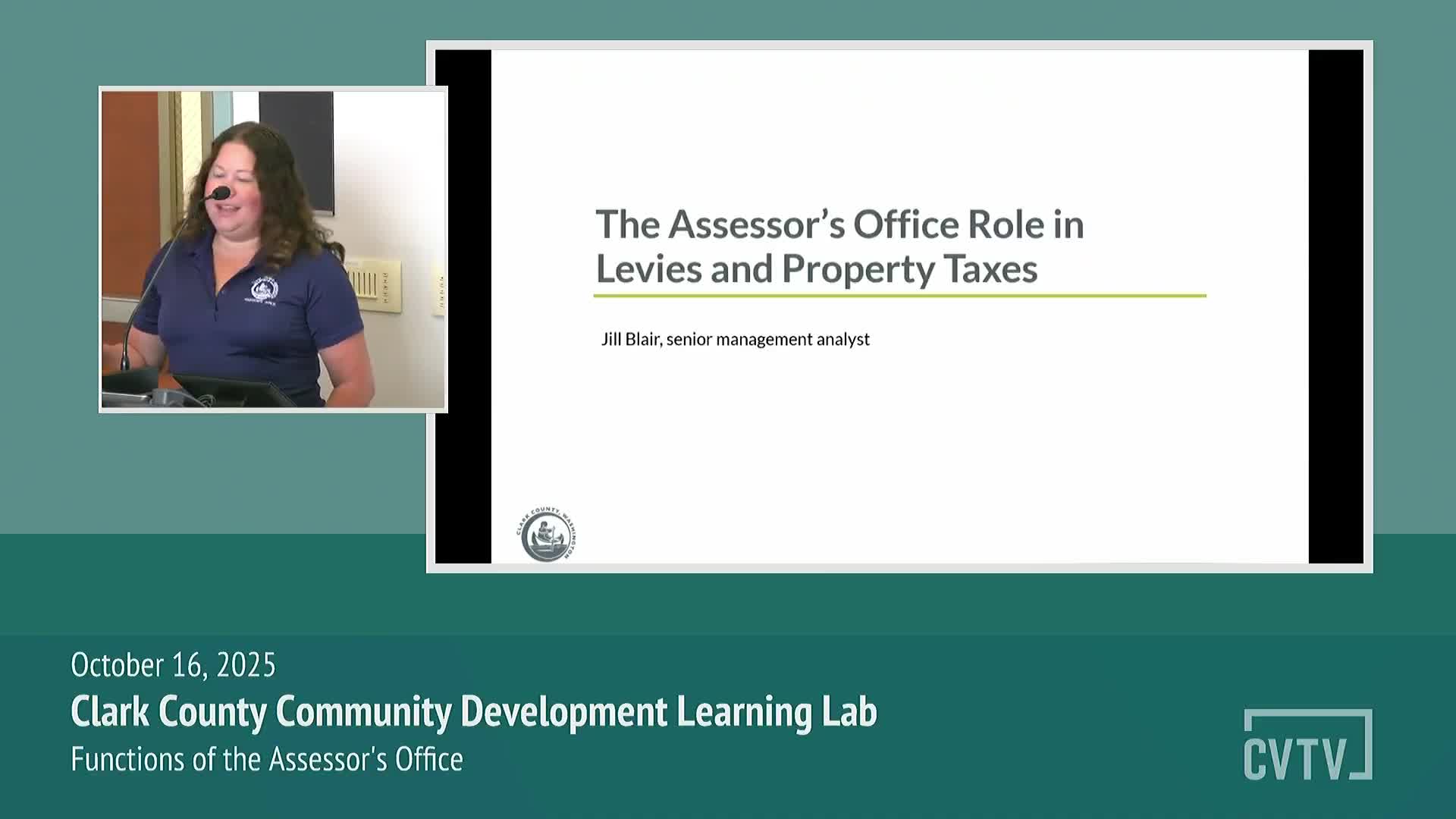Clark County levy specialist outlines how taxing districts set levies and limits
October 20, 2025 | Clark County, Washington
This article was created by AI summarizing key points discussed. AI makes mistakes, so for full details and context, please refer to the video of the full meeting. Please report any errors so we can fix them. Report an error »

Jill Blair, senior management analyst and levy specialist in the Clark County assessor's office, explained how taxing districts set budgets that are converted into property tax levies, the statutory limits that constrain those levies, and how the assessor's office calculates levy rates for tax bills.
Blair said taxing districts independently set budgets and submit them to county council; the assessor converts those budgets into levy rates by dividing a district's required revenue by the assessed values inside the district. Several statutory limits can constrain how much revenue a district actually collects.
Blair said the four primary levy controls are:
- Resolution limit: each district must pass a resolution authorizing increases over its previous levy collection when applicable.
- Certified levy request: the budget amount a district asks to collect.
- The 1% limit (often called the 1% cap): districts generally cannot increase their levy collections more than 1% over the previous year’s collection, except where new construction or other specifically allowed growth occurs or where voters approve a lid lift.
- Statutory maximum levy rates: some district types have an absolute legal maximum levy rate.
She also explained two combined limits applied after individual levy calculations: the $5.90 limit (a cap on the combined rate of certain local levies such as county, city and fire) and the constitutional limit often described as a maximum tax burden per $1,000 of assessed value (sometimes referenced as a $10-per-$1,000 market-value ceiling). Blair said the constitutional limit has not constrained Washington counties in recent years but that the assessor's office checks it annually.
Blair emphasized the budget-based nature of Washington’s system: when assessed values rise, levy rates can fall for a given budget, which helps stabilize tax bills. She urged residents to participate in local budget hearings and vote on ballot measures when districts seek voter-approved increases. “Pay attention to ballot measures and vote in local elections,” she said.
All quotations and attributions in this article come from Jill Blair (senior management analyst/levy specialist). Less-critical procedural notes included: county districts can certify by December 15, non-county districts must submit budgets in December, and taxing districts vary widely in Clark County (seven cities and one town were noted during the presentation).
Blair said taxing districts independently set budgets and submit them to county council; the assessor converts those budgets into levy rates by dividing a district's required revenue by the assessed values inside the district. Several statutory limits can constrain how much revenue a district actually collects.
Blair said the four primary levy controls are:
- Resolution limit: each district must pass a resolution authorizing increases over its previous levy collection when applicable.
- Certified levy request: the budget amount a district asks to collect.
- The 1% limit (often called the 1% cap): districts generally cannot increase their levy collections more than 1% over the previous year’s collection, except where new construction or other specifically allowed growth occurs or where voters approve a lid lift.
- Statutory maximum levy rates: some district types have an absolute legal maximum levy rate.
She also explained two combined limits applied after individual levy calculations: the $5.90 limit (a cap on the combined rate of certain local levies such as county, city and fire) and the constitutional limit often described as a maximum tax burden per $1,000 of assessed value (sometimes referenced as a $10-per-$1,000 market-value ceiling). Blair said the constitutional limit has not constrained Washington counties in recent years but that the assessor's office checks it annually.
Blair emphasized the budget-based nature of Washington’s system: when assessed values rise, levy rates can fall for a given budget, which helps stabilize tax bills. She urged residents to participate in local budget hearings and vote on ballot measures when districts seek voter-approved increases. “Pay attention to ballot measures and vote in local elections,” she said.
All quotations and attributions in this article come from Jill Blair (senior management analyst/levy specialist). Less-critical procedural notes included: county districts can certify by December 15, non-county districts must submit budgets in December, and taxing districts vary widely in Clark County (seven cities and one town were noted during the presentation).
View full meeting
This article is based on a recent meeting—watch the full video and explore the complete transcript for deeper insights into the discussion.
View full meeting
